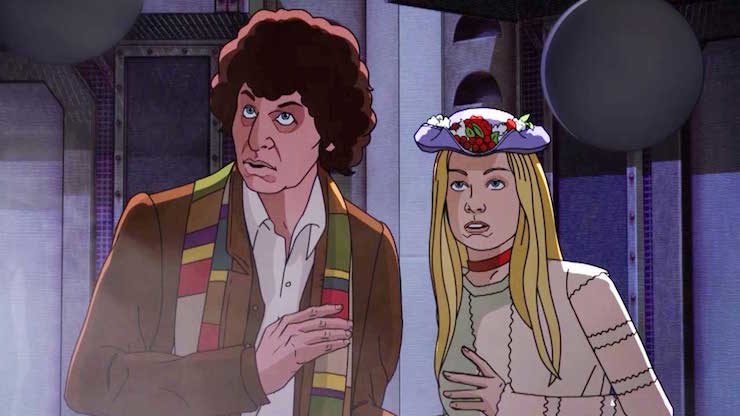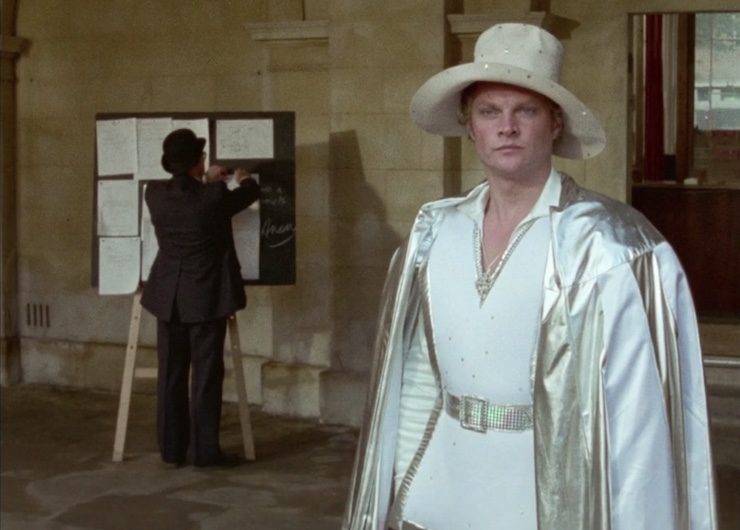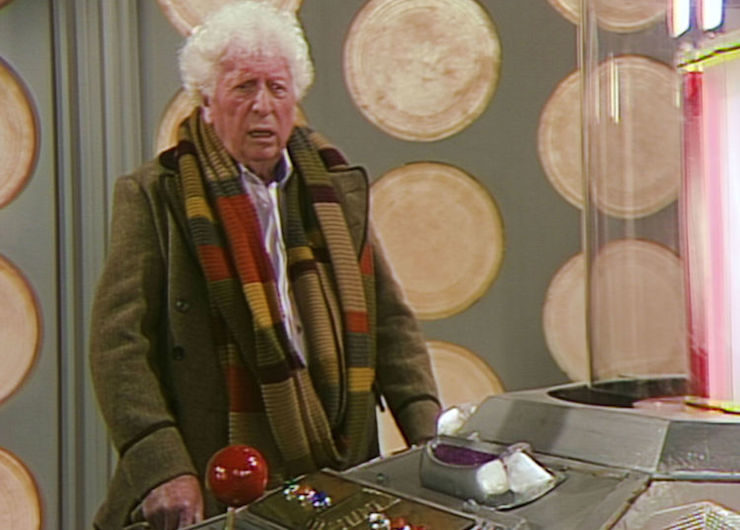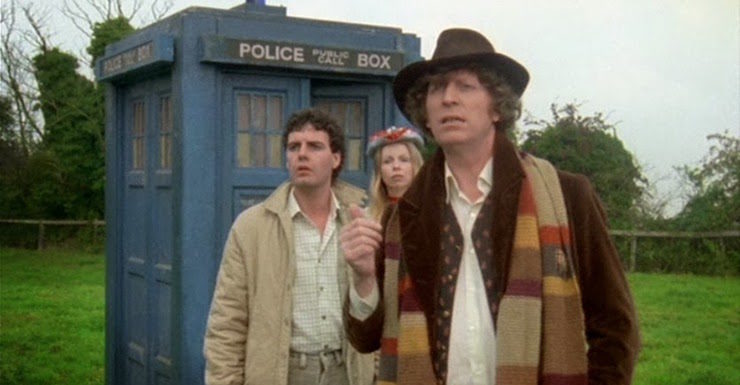“Shada” is a Doctor Who story that’s always been folded away in strange pockets of the show’s history (which, given the direction the plot ultimately takes, is oddly appropriate). Initially recorded as part of Season 17, which aired in 1979 and 1980, the serial was abandoned due to a labor strike at the BBC. Written by Douglas Adams and representing one of Tom Baker’s final appearances in the role, it sits between decades, at the edge of the Fourth Doctor’s tenure and just before the next regeneration. “Shada” has lingered in a state that’s been both well documented and frustratingly incomplete. Numerous attempts have been made to finish the story, including a Big Finish audio drama starring the Eighth Doctor, a novelization, and a video release with Baker explaining what happened in the scenes that were never shot. All of them have tried to close the circle that “Shada” opened decades ago. None have quite managed it as it was intended.
But now, at last, this story that has haunted Doctor Who in various forms for decades has been completed, using the surviving original cast (including Tom Baker), 1970s effects techniques and vintage equipment, and modern animation to complete the story. “Shada” was released as a digital download last week and will be available on DVD and Blu-Ray towards the end of the year. It’s still as confounding and contradictory in completion as it ever was as in fragments—which, somehow, seems both intensely Gallifreyan and extremely appropriate.
“Shada” sees the Fourth Doctor and Romana arrive in Cambridge at the request of Professor Chronotis. Chronotis is a Time Lord like the Doctor but one at the far end of his lives and quietly, disreputably, retired. Chronotis “borrowed” a few things when he left. Like a TARDIS, and a Gallifreyan book that holds the key to the mysterious “Shada,” a name that no one recognises but that Skagra, the story’s villain, is willing to kill for…
The brave, and successful, choice that’s been made by producer and director Charles Norton is to structure this initial release as a single story. The old school cliffhangers are still very much present, but this is “Shada” as a continuous cut rather than individual episodes, and it benefits tremendously from that approach. There’s even an extended cold open which cleverly sets the story very much in the modern format and helps mitigate the initial speed bumps of the production values and period. While I know some viewers will dislike this, my hope is that physical release will have the story broken down into episodes as well as this unified format.

That’s not the only impressive choice Norton’s made. The animation hits the exact right balance of simple and full of character and was, I found out at a press event, based heavily on green screen footage of the actors. It also means that Norton gets to have a little fun, and there are some well-handled moments of visual wit that really lift those scenes. In particular, Chris Parsons’ (Daniel Hill) first encounter with the Gallifreyan book has some lovely temporal effects in the background that are both funny and deeply disturbing, for example. Similarly, every license plate, name tag, and other background details contain carefully crafted in-jokes.
The care taken with the animation also provides an ancillary benefit as you get a distinct impression of just how scattered the filmed material originally was. There’s even a single shot of one of the final scenes in the can, but nothing around it. If you’re a process fan, and a lot of Who fans are, then simply watching this is going to give you a feel for how the show was put together as well as how it was written and paced. Or to put it another way: if you’re a Process Gonk then Professor Chronotis’ class is most definitely in session.
The new model work and music both impress, too, and Norton and his team are to be applauded for their use of 70s techniques, equipment, and staff who are experienced in both. I always fight shy of genre’s general obsessive romanticization of its own past (even more so with Doctor Who, in particular), but the care, and love, that went into this reconstruction speaks for itself.
A lot of the story itself is fun, too, if weirdly uneven in pacing and location. The first half takes place entirely on location in Cambridge, with Romana and The Doctor visiting Professor Chronotis and Chris Parsons accidentally borrowing the most dangerous book in the world. This is vintage Douglas Adams, and the legendary writer’s quick-fire wit is very much on display here. If anything, there’s rather too much of it; much like the Tenth Doctor and Rose sometimes did, Romana and the Fourth Doctor often come across as belligerently smug in these opening episodes. It gives some scenes a brittle, almost mean-spirited feel that flies in sharp contrast to the beloved qualities for which the Fourth Doctor era is remembered (and maybe explains why Adams wasn’t that upset the story was never finished).

That feeling is driven home by Skagra, the villain of the piece. Christopher Neame is great in the role but the extended scenes of him—space tunic, cloak, and jaunty spaceketeer hat in place, wandering around Cambridge with an evil mind-eating ball (yes, really) in his bag—drag, and drag badly. Worse still, the reveal on just what he is and where’s he from is fascinating and could have powered the entire story; instead, it’s dashed off as very nearly the final line.
The second half fares much better, as Adams throws a nested series of reveals at us that all add up to something pleasingly inventive—Skagra’s base of operations, Professor Chronotis’ varying levels of deadness, the complexities of Time Lord history, and a surprisingly effective journey through the Vortex all combine to make the second hour breeze along. Victoria Burgoyne as Claire Keightley and Daniel Hill as Chris Parsons especially impress, too. You can see the bow wave of Doctor Who’s modern day companion dynamic here and it’s a shame that the show never returned to Claire, in particular. Likewise, Denis Carey is excellent as Professor Chronotis (although his uncanny resemblance to Patrick Troughton is a little disconcerting at first), cutting a pleasingly ambiguous, often slightly frightening figure.
All in all, for every weakness “Shada” has, there’s a strength. The dated wardrobe is balanced by the scale escalation in the second act. Skagra’s resolute lack of threat is balanced by Chronotis’ unusual position in the show, and so on. Even the Doctor’s brittle arrogance is balanced by one of the closing notes, which ties the story sweetly to the present day while still keeping it anchored in the past.

That’s very much what “Shada” is: a bridge between two periods. From the cheeky, “Slightly later than advertised” opening introduction to the final scene, this is a deep dive into a Doctor Who story that’s been defined by and best known for its lack of closure. Now, at last, we have that closure and it shows us something truly unusual. For all its numerous faults, “Shada” is a vital link between the old show and the new—not quite one, not quite the other, vital to both. How quintessentially “Shada.” How cheerfully Gallifreyan. How perfectly Doctor Who.
Alasdair Stuart is a freelancer writer, RPG writer and podcaster. He owns Escape Artists, who publish the short fiction podcasts Escape Pod, Pseudopod, Podcastle, Cast of Wonders, and the magazine Mothership Zeta. He blogs enthusiastically about pop culture, cooking and exercise at Alasdairstuart.com, and tweets @AlasdairStuart.










